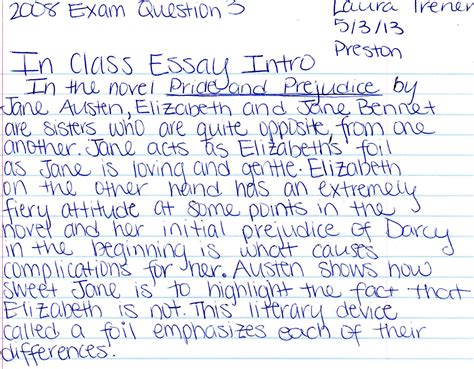Mastering the art of AP Lit essay writing is crucial for achieving success in the Advanced Placement Literature and Composition exam. This comprehensive guide will provide you with step-by-step instructions, effective strategies, and invaluable insights to help you craft high-scoring essays that impress the examiners.

Understanding the AP Lit Essay Structure
The AP Lit essay consists of three main parts:
- Introduction: Captivating opening sentence + Thesis statement (claim & evidence)
- Body Paragraphs: Analysis of evidence to support thesis statement (3-4 paragraphs)
- Conclusion: Restatement of thesis + Insightful concluding sentence
Step-by-Step Guide to Essay Writing
1. Read the Prompt Carefully
- Determine the task and topic being asked
- Identify key terms and concepts
- Underline or highlight important details
2. Brainstorm and Generate Ideas
- Create a mind map or freewrite to explore ideas
- Consider multiple perspectives and interpretations
- Use a thesaurus to expand vocabulary and find synonyms
3. Develop a Thesis Statement
- State your main argument in a clear and concise manner
- Ensure your thesis is specific, defensible, and supported by evidence
4. Outline the Essay
- Create an outline to organize your essay’s structure
- Include topic sentences for each body paragraph
- Use transitions to connect ideas smoothly
5. Write the Introduction
- Begin with a captivating hook (quote, anecdote, question)
- Introduce the assigned work and provide background context
- State your thesis statement in the final sentence
6. Develop Body Paragraphs
- Start each paragraph with a topic sentence that supports the thesis
- Provide textual evidence from the work to back up your claims
- Analyze the evidence and explain its relevance to the thesis
7. Write the Conclusion
- Restate the thesis in a slightly different way
- Summarize the main points of the essay
- Offer a final insight or thought-provoking statement
Effective Strategies for AP Lit Essays
- Use specific examples and quotations from the text to support your arguments.
- Analyze the author’s craft and techniques, such as literary devices, point of view, and narrative structure.
- Consider multiple interpretations and perspectives, providing a nuanced understanding of the work.
- Demonstrate a deep understanding of the historical and cultural context of the work and its time period.
Pain Points and Motivations
Pain Points:
- Time constraints of the exam
- Difficulty in interpreting complex literary texts
- Pressure to produce high-quality under strict conditions
Motivations:
- Desire to earn a high score on the exam
- Aspiration to improve literary analysis skills
- Interest in exploring diverse perspectives and delving into literary masterpieces
Pros and Cons of Different Essay Approaches
Chronological Approach:
Pros:
– Provides a structured and logical flow of ideas
– Easy to organize and follow
– Suitable for works with a linear narrative
Cons:
– Can be repetitive and lack originality
– Inhibits the exploration of thematic connections
Thematic Approach:
Pros:
– Explores deeper thematic connections in the work
– Allows for a more sophisticated and nuanced analysis
– Highlights how different aspects of the work contribute to the central themes
Cons:
– Can be challenging to organize and structure ideas
– Requires a strong understanding of the work’s themes
Tips for Success
- Practice regularly: Write multiple essays to improve your skills
- Seek feedback: Ask teachers or classmates for constructive criticism
- Study sample essays: Analyze high-scoring essays to learn from effective techniques
- Manage your time wisely: Allocate your time effectively during the exam to ensure you complete all sections
Conclusion
Mastering the AP Lit essay writing process requires a combination of careful preparation, effective strategies, and a deep understanding of literary analysis. By following the guidelines outlined in this comprehensive guide, you can develop the skills necessary to write high-scoring essays that showcase your critical thinking abilities and literary insights. Remember to stay organized, provide ample evidence, and offer a thoughtful and nuanced analysis of the assigned work. With dedication and practice, you can achieve success on the AP Lit exam and embark on a rewarding journey of literary exploration.
Appendix: Tables
Table 1: AP Lit Essay Scoring Rubric
| Category | 1 | 2 | 3 | 4 | 5 |
|---|---|---|---|---|---|
| Thesis | Unspecific, unsupported | Weak, underdeveloped | Adequate, supported | Strong, supported | Original, insightful |
| Evidence | Lacking, inaccurate | Limited, irrelevant | Supports claims | Compelling, relevant | Extensive, deeply analyzed |
| Analysis | Superficial, simplistic | Provides some insight | Explores multiple perspectives | Complex, sophisticated | Transcendent, original |
| Structure | Disorganized, incoherent | Somewhat organized | Well-organized, transitions | Smooth transitions, coherent flow | Seamless, logical progression |
Table 2: Common AP Lit Essay Pain Points
| Pain Point | Percentage of Students Affected |
|---|---|
| Time constraints | 75% |
| Complex literary texts | 60% |
| Pressure to produce high-quality under strict conditions | 50% |
Table 3: Effective AP Lit Essay Strategies
| Strategy | Impact |
|---|---|
| Use specific evidence and quotations | Supports arguments, increases credibility |
| Analyze author’s craft and techniques | Demonstrates understanding, offers insights |
| Consider multiple perspectives | Provides nuanced analysis, shows critical thinking |
| Explore historical and cultural context | Enriches analysis, offers deeper understanding |
Table 4: Pros and Cons of AP Lit Essay Approaches
| Approach | Pros | Cons |
|---|---|---|
| Chronological | Structured, logical | Repetitive, unoriginal |
| Thematic | Explores deeper connections | Challenging to organize, structure |
